|
|
Vaughan, Ontario – Saturday, September 15th & Sunday, September 16th, 2012
 The back half of the park approaching the kids area feels a bit underdevloped compared to the front half, not sure if there's zoning or noise considerations back here that have prevented any tall structures. That would be fine, if this area didn't also feel so blandly utilitarian. (By the way, that's my friend Chris in the white shirt just ahead of me.)  Silver Streak, themed to the fun and excitement of mass transit. For kids.  Silver Streak is one of the older model Vekoma family suspended coasters, back when they still came with these hideous over the shoulder restraints.  Nearly a half hour later, we're finally about to board. #597.  It wasn't as abjectly terrible as some of the other Paramount-era family inverted coasters I've done, but I don't know why they continue to make family rides so low-capacity that there's always an unnecessarily long wait for them.  A photo of a roller coaster I did not ride.  Approaching Planet Snoopy, the park becomes surprisingly beautiful with these huge mature trees and landscaped gardens everywhere.  Again, there are small pockets of this park that feel more European in design with large, open, grassy areas.  I'm not a huge fan of the Planet Snoopy branding that's going into Cedar Fair parks (the pop-art look and "Planet" branding really doesn't match the tone of the Peanuts at all), but the abundant greenery and fact that it's relatively undisturbed by the rest of the park makes Canada's Wonderland's one of the better kiddie areas I've walked through.  By the way, they also have the Ghoster Coaster, which is probably in contention for being one of the top five most enjoyable coasters in the park.  It originally opened as Scooby's Gasping Ghoster Coaster in 1981, and it's nice to see them preserve some of that history even if Scooby has long since left the house.  The simple presence of buzz bars is already enough to make this one of the park's must-ride attractions.  Two train operation also helps. The layout is familiar to me as Zach's Zoomer at Michigan's Adventure was my first almost-full-sized coaster.  Ghoster Coaster runs quickly and smoothly with some good float over the drops.  Verdant foliage and large iron rides just go so well together.  Drop Tower stands 227 feet tall, which ties it for the world record for the worst drop tower ride name ever.  Drop Tower and The Bat  The Bat is a Vekoma Boomerang that seems way more popular with the local crowds than it should be.  Sometimes when I ride a Vekoma Boomerang, I try to imagine how I would respond if this were my very first ride on a coaster like this. Am I able to authentically replace my disgust with purer, more joyful emotions?  No.  Night Mares is another of Canada Wonderland's unique and relatively rare flat rides. Unfortunately I didn't get a photo of the ride itself, but it's sort of like a mix between a Super Round-Up and an Enterprise.  Canada Wonderland's Medieval Faire section was recently renovated to once again look more medieval.  Thunder Run is Canada's Wonderland's powered coaster that takes place inside the Wonder Mountain.  Here's another attraction that makes Canada's Wonderland subtly feel more European than American. Powered coasters (at least those that are seen as acceptable for adults and kids) are exceedingly rare south of the border, but across the pond these types of rides are quite plentiful.  Wild Beast would be exceedingly boring if it wasn't so excruciatingly rough. While it's a tough call with the Mighty Canadian Minebuster on the opposite side of the park, I think I'm going to declare Wild Beast the worst wooden roller coaster I've ever ridden. I'm actually rather pleased of the fact, as my distaste for this pitiful excuse for a termite buffet has expanded the spectrum of emotions I previously thought I could feel about a ride. It's like discovering you can hear a new frequency that was previously beyond your auditory range, the only downside being that it's also the brown note.  Such a terrible coaster is the Wild Beast, I actually have no photos of the structure itself. So here's an image of the best part of the ride, this piece of public sculpture. I wish more parks could install random art installations like this, instead of it always having to be "theming".  Another one of these sculptures belongs to Dragon Fire, Medieval Faire's 4-loop Arrow Dynamics steel coaster.  This was one of four coasters that opened with the park in 1981, and the only steel coaster.  Dragon Fire is unique among Arrow loopers for having its double corkscrew spin counterclockwise instead of clockwise like nearly every other Arrow-designed corkscrew. Apart from that quirk, the layout's pretty conservative, even by 1981 standards. Loch Ness Monster and Orient Express were already thrilling riders a couple years before Dragon Fire ever hit the scene.  I'm having a hard time focusing on Dragon Fire, though I'm not sure what's distracting me...
Mason, Ohio – Friday, May 8th, 2009

Departing from Lansing early that morning we arrived to Kings Island shortly after its 10:00am opening time planning for a full day at the park. The weather wasn’t supposed to be great but when we arrived it was clear if not very humid. The parking setup they have is somewhat confusing, since I presented my voucher for a Platinum Kings Island pass which is supposed to get us into the closer premium lot, but instead we somehow still got shuttled into the regular lot. Not much of a problem since the crowds were still fairly light that morning. I was fearful of what the wait for season pass processing would be like and was quite pleased to find that not only did the process now take less than a minute, there consequently was no line. The time it took to find the processing center (it’s just off to the left of the main gates) easily outweighed the time it took to get it processed. Inside the park we went straight to start out the season with a front row ride on Diamondback. Every detail about that ride can be found in my Diamondback Analysis. After two rides there we went over to the Beast, which I again will not elaborate here since that can all be found in my Beast 30th Anniversary Analysis.
Okay, now that I’ve got all those requisite-of-every-amusement-park-trip-report anterior ramblings out of the way it’s time to get to the meat of the story.
With the additions of all these high-profile new attractions from respected designers to the former Paramount Parks a lot of people are saying that Cedar Fair is the best thing to ever happen to Kings Island. Count me out of that group. After experiencing the park that day it became clear to me that Cedar Fair has totally and wholly become the new Premier Parks/Six Flags. That’s not to say that I wish the former Paramount management back into their parks, since they did display a general incompetence in choosing their ride systems. (If it wasn’t a flat-out bad decision it was still a relatively conservative investment compared to what the rest of the industry was doing; Son of Beast was the chain’s last real attention-grabbing installation and look how well it turned out after a few years… more on that one later). But Cedar Fair seems to be adopting an attitude that is turning the parks into expensive corporatized carnivals. Rides, shows and buildings compete for your attention as totally compartmentalized structures threaded together by a midway, rather than try to coalesce into a complete and complementary mise-en-scène as it had been during the Duell years of amusement park design during the 1960’s and 70’s. I am aware that KI was not one of R. Duell’s work, but Taft seemed to be following the same philosophy when it was first designed and the park fits in that same strand of theme park history. For the most part Paramount tried it’s best to retain that feeling of grandeur to their parks except perhaps their last few years when Italian Job was plopped down in the middle of what had formally been the beautifully landscaped heart of the park. (Looking at satellite imagery, it would have fit PERFECTLY in the Action Zone where the go-karts and part of King Cobra used to fit, WHY didn’t it go there? Now we’ve got Diamondback filling in the other half of that peaceful centerpiece and the park is now completely homogenized to meld with the Action Zone area) during the 1960’s and 70’s. I am aware that KI was not one of R. Duell’s work, but Taft seemed to be following the same philosophy when it was first designed and the park fits in that same strand of theme park history. For the most part Paramount tried it’s best to retain that feeling of grandeur to their parks except perhaps their last few years when Italian Job was plopped down in the middle of what had formally been the beautifully landscaped heart of the park. (Looking at satellite imagery, it would have fit PERFECTLY in the Action Zone where the go-karts and part of King Cobra used to fit, WHY didn’t it go there? Now we’ve got Diamondback filling in the other half of that peaceful centerpiece and the park is now completely homogenized to meld with the Action Zone area)
The Cedar Fair philosophy of park layout planning and design seems to have big investments especially like Behemoth and Diamondback (although many other new coasters such as most of the Geauga Lake relocations, WoF’s Patriot and Knott’s Silver Bullet) appeal to guest as a very expensive, high-end carnival ride, essentially. They’re designed to dominate their surroundings and call as much attention to themselves as they can, in nearly the exact same way a carnival ride is designed by its manufacturers to stand out wherever it happens to be placed along a generic midway filled with other rides also competing for your attention.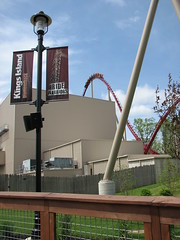
There actually is some theoretical justification to this sort of park design that’s been in place as early as the 1980’s and has been present in nearly every major theme park (although probably best personified by Cedar Fair) to this day, and it’s not a surprise that this type of park design has emerged almost exclusively from the more corporatized parks in the United States: Economics. Classical economic theory states, among much else, that in a case where you have several individuals inhabiting the same system (in this case, individual rides and attractions within a singular amusement park), what is best for each individual is therefore best for the system. Why hold a certain ride back from appearing as spectacular in the park as it could be, just for the sake of other lesser attractions around it? A perfectly valid and logical argument, however it is from that argument that the ‘expensive carnival’ conclusion necessarily arises when all their coasters are painted the flashiest colors imaginable and I think that is something that anyone can agree is not what we’re looking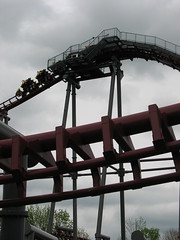 for out of a top-end regional theme park. for out of a top-end regional theme park.
Transitioning from those thoughts I’ll start the reviews with Firehawk, the first major addition to the park preformed entirely under the Cedar Fair banner. I’ve always liked this ride for what it is, mostly from my experience on it back at Geauga Lake/Six Flags Worlds of Adventure. I only got one ride on it back in 2007 when it first opened thanks to the long lines, and unfortunately long lines were encountered here as well. One side of the station was open but with both trains being run, which didn’t make that big of an impact because the time it took for the second train to make it from the main brake run to the station, raise the cars and get the last load of riders off the other train was already back to the main brakes. I’m quite positive they have (or had) a third train with this ride that might have been refurbished and put into service a year after opening, but it seems as though those plans have been scrapped, and a shame, too. The coaster works better as a generic looper that crosses between inverted and upright styles than a “flying experience” as the park would have advertised. If I could fly,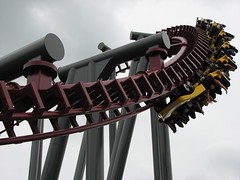 I imagine I would fly smoothly and gracefully rather than shunt around the track as this ride had (there was a very loud squealing that accompanied the trains today), and the whole effect is lost anyway by the ride’s placement over an empty field with nothing but concrete footers below. The B&M flyers probably do a much better job at providing this experience, although of the three of those kind that I’ve been on (the Superman Ultimate Flight trio) none have yet resolved the ‘open field’ problem yet. Again with these expensive carnival coasters… But as I said, it’s an okay ride if you think of it as a kind of bizarre inverted/sitdown looper combo rather than a flying coaster, fitting in well for the park with the likes of Invertigo, Vortex and Flight of Fear, the last of which I’ll review next. I imagine I would fly smoothly and gracefully rather than shunt around the track as this ride had (there was a very loud squealing that accompanied the trains today), and the whole effect is lost anyway by the ride’s placement over an empty field with nothing but concrete footers below. The B&M flyers probably do a much better job at providing this experience, although of the three of those kind that I’ve been on (the Superman Ultimate Flight trio) none have yet resolved the ‘open field’ problem yet. Again with these expensive carnival coasters… But as I said, it’s an okay ride if you think of it as a kind of bizarre inverted/sitdown looper combo rather than a flying coaster, fitting in well for the park with the likes of Invertigo, Vortex and Flight of Fear, the last of which I’ll review next.
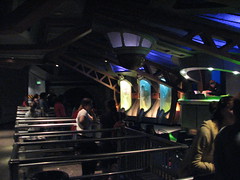 The line for Flight of Fear was thankfully very short, and we were able to snag a front row ride after only two cycles. I think this could be one of the best rides in the park if only they would turn off that midcourse brake which brings it to a complete stop. The first cobra roll and a half are extremely powerful and disorienting. My dad commented after the ride that at first he had no The line for Flight of Fear was thankfully very short, and we were able to snag a front row ride after only two cycles. I think this could be one of the best rides in the park if only they would turn off that midcourse brake which brings it to a complete stop. The first cobra roll and a half are extremely powerful and disorienting. My dad commented after the ride that at first he had no 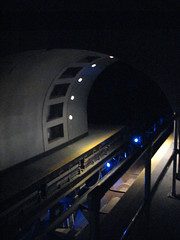 clue which way was up or down, a testament to both the high g-forces that are sustained all the way around that don’t give away which direction gravity is pulling us, and the lack of spatial awareness created by the darkness and spider web of track whizzing by. Then after a few more turns the midcourse brake kicks in and completely transforms the ride. It is now all-too clear which direction gravity is pulling us, which is most likely 90 degrees to the side since the banking in this section was clearly intended for speeds closer to 55 mph, not 5. It finally gets a bit more pep back in its step towards the end with the low-to-the-floor left curve that has a great moment of a false banking rise as if to enter a corkscrew, followed by another banking rise that leads us into an actual corkscrew to cap off the ride experience. This probably is still one of my favorite launched or indoor coasters around, just the amount of track and supports wound into that room still boggles my mind. clue which way was up or down, a testament to both the high g-forces that are sustained all the way around that don’t give away which direction gravity is pulling us, and the lack of spatial awareness created by the darkness and spider web of track whizzing by. Then after a few more turns the midcourse brake kicks in and completely transforms the ride. It is now all-too clear which direction gravity is pulling us, which is most likely 90 degrees to the side since the banking in this section was clearly intended for speeds closer to 55 mph, not 5. It finally gets a bit more pep back in its step towards the end with the low-to-the-floor left curve that has a great moment of a false banking rise as if to enter a corkscrew, followed by another banking rise that leads us into an actual corkscrew to cap off the ride experience. This probably is still one of my favorite launched or indoor coasters around, just the amount of track and supports wound into that room still boggles my mind.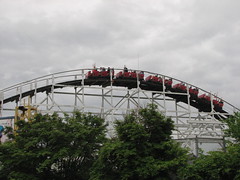
Continuing on through the Coney Mall section of the park is their original coaster The Racer. I feel that John Allen doesn’t get nearly enough credit as he deserves among today’s coaster enthusiasts, although it is perhaps understandable given that his surviving designs all tend to handle much rougher than they should. A long series of parabolic airtime hills on the way out and back, with nothing but a slight dogleg along each course and a turnaround at the far end. If you can try to tune out the bad tracking (which on all of my experiences has alternated between “hardly even noticeable” and “my head was placed inside a paint mixer”) the perfectly parabolic profiling of the hills is still very present to this day, a very gentle lift from the seat, sustained, and then easily set back down (unlike a circular hill where the sharpest airtime is at the entry and exit of the curve, and the weakest is at the apex; even CCI worked with this model for most of their lifetime). If the ride ever could get back a lighter, more flexible set of trains with single-position lapbars I’m positive this ride would rank high as one of the most joyfully blissful, aesthetically attuned coaster experiences ever to grace plant Earth.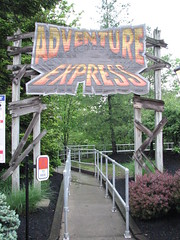 With modern wooden coaster criteria requiring so many changes in dynamics to be considered a well-rounded or worth-while ride I’d really like to see a ride like the Racer show all of those rides up for it’s simple, straightforward beauty. With modern wooden coaster criteria requiring so many changes in dynamics to be considered a well-rounded or worth-while ride I’d really like to see a ride like the Racer show all of those rides up for it’s simple, straightforward beauty.
Just beyond the Racer is another small gem that only those who have actually been to Kings Island likely know about: Adventure Express. This is probably the best mine train I’ve ever been on, with the possible exception of Silver Dollar City’s Thunderation (also a late-era Arrow mine train), but that one lacks the extended, meandering layout and somewhat lackadaisical pacing that was signature to the original mine rides and still present in Adventure Express. It manages both real speed and forces, a long layout that’s hard to memorize (whenever I fear it’s about to end I remember there’s still an entire section left to go) several distinct areas of themeing as well as interaction with the natural terrain, plus the greatest surprise ending of all time. Whatever you’re expecting from the ending, expect the opposite. And then you’ll be surprised.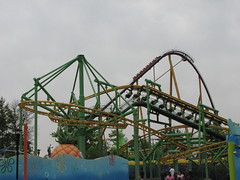
Before heading over to review the rides in the Action Zone area of the park I recall making a quick stop through the Nickelodeon Universe area of the park, which I’ve never been through since I was part of the demographic intended. Rugrats Runaway Reptar was new for me, even though I’ve been on the version at Carowinds and did not like it. This one felt a bit better for me, probably through random chance that I didn’t bang around as much however since this one also felt much more hurky-jerky than it needs to be, especially considering it isn’t at all fast. After that I headed over to the Fairly Odd Coaster (née Beastie, née Scooby Doo) just as a few light sprinkles started coming down. I could have sworn that this ride had a small tunnel at the bottom of the first drop at one point… 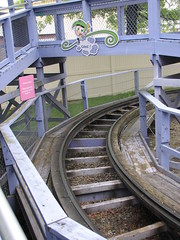 (one minute later I see on the RCDB that it did in fact have a tunnel, which now raises the question why did they purposely decide to rid of it?) Shortly after disembarking that slightly wet ride the rain started to come down much harder. At first I headed over to the Beast only to find it closed, where I waited around for a few minutes before deciding to ditch it and head back to the car where my dad went to rest for an hour or so. On my way through I stopped at the Scooby Doo Haunted Mansion dark ride, which was the only ride so far as I could tell that was still open from the rain. I wasn’t really sure what to expect… this is the first dark ride I’ve been on that uses a continuous chain of cars that all move at the same speed, with riders boarding and exiting from a turntable similar to the old White Water Landing at Cedar Point. Props and story are pretty unimpressive, although that’s almost a requisite of any interactive dark ride just by their very nature, and that’s partly why I (one minute later I see on the RCDB that it did in fact have a tunnel, which now raises the question why did they purposely decide to rid of it?) Shortly after disembarking that slightly wet ride the rain started to come down much harder. At first I headed over to the Beast only to find it closed, where I waited around for a few minutes before deciding to ditch it and head back to the car where my dad went to rest for an hour or so. On my way through I stopped at the Scooby Doo Haunted Mansion dark ride, which was the only ride so far as I could tell that was still open from the rain. I wasn’t really sure what to expect… this is the first dark ride I’ve been on that uses a continuous chain of cars that all move at the same speed, with riders boarding and exiting from a turntable similar to the old White Water Landing at Cedar Point. Props and story are pretty unimpressive, although that’s almost a requisite of any interactive dark ride just by their very nature, and that’s partly why I  don’t buy a lot of the industry chatter that says that the future of theme parks is in more interactive entertainment. Well, I didn’t make any use of the shooter anyway because I was without competition and was planning on just taking pictures inside the whole thing, but only one picture into the ride the camera froze up and informed me it was out of memory space; apparently my dad forgot to tell me he still had several hundred photos from some random graduations and football games stored on there. Thankfully immediately after the ride I met up with him at the car and we deleted unnecessary photos, uploaded the first batch on my laptop, then, contemplating the permeating sour weather, decided to pack up for the afternoon and found a Subway nearby for lunch. I afterward called my mother to let her know how things were going and to see if she could look up the weather forecast to see if it would be like this throughout the rest of the evening. Happily she informed me that it appeared as though it might blow over within the next 30-45 minutes. don’t buy a lot of the industry chatter that says that the future of theme parks is in more interactive entertainment. Well, I didn’t make any use of the shooter anyway because I was without competition and was planning on just taking pictures inside the whole thing, but only one picture into the ride the camera froze up and informed me it was out of memory space; apparently my dad forgot to tell me he still had several hundred photos from some random graduations and football games stored on there. Thankfully immediately after the ride I met up with him at the car and we deleted unnecessary photos, uploaded the first batch on my laptop, then, contemplating the permeating sour weather, decided to pack up for the afternoon and found a Subway nearby for lunch. I afterward called my mother to let her know how things were going and to see if she could look up the weather forecast to see if it would be like this throughout the rest of the evening. Happily she informed me that it appeared as though it might blow over within the next 30-45 minutes.
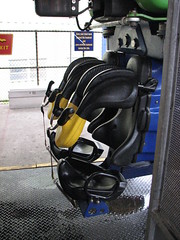 Shortly afterward we found ourselves re-entering the park and heading left toward Invertigo, which they opened the queue for right as we were walking up to it making us only second in line. Score! My favorite seat has always been second to the rear on the ride, the farthest back that’s facing forward on the first circuit. Not only do you get the best vertigo-inducing view straight down when climbing the first lift, my neuroses dictate that I should Shortly afterward we found ourselves re-entering the park and heading left toward Invertigo, which they opened the queue for right as we were walking up to it making us only second in line. Score! My favorite seat has always been second to the rear on the ride, the farthest back that’s facing forward on the first circuit. Not only do you get the best vertigo-inducing view straight down when climbing the first lift, my neuroses dictate that I should  experience the ride first forward and then backward, as to do the opposite would not make much logical sense. I actually kind of disliked this particular ride- the positive g-forces and slight rattle in the cars really strained my neck and this was the closest I ever got to getting a headache from a coaster in a long time. Still, I must give huge props to Vekoma for the innovation of having riders sit face-to-face. experience the ride first forward and then backward, as to do the opposite would not make much logical sense. I actually kind of disliked this particular ride- the positive g-forces and slight rattle in the cars really strained my neck and this was the closest I ever got to getting a headache from a coaster in a long time. Still, I must give huge props to Vekoma for the innovation of having riders sit face-to-face.
Exploring the ‘new’ park, the renaming of nearly every attraction that needed to be changed to avoid copyright infringement once their Paramount licensing was lost is frankly quite embarrassing. Top Gun’s transformation into “Flight Deck” or Drop Zone: Stunt Tower’s transformation into “Drop Tower” I think tells a lot about the attitude of the Cedar Fair management. Rather than re-brand their newly acquired Paramount Parks to be given a fresh identity to distinguish themselves from the old regime, Cedar Fair decided to find names that would allow them to both avoid re-themeing attractions AND avoid paying for even a trademark, let alone for licensing royalties. This is either genius or idiocy. Who ever thought that Flight Deck was even acceptable for a name? I’ll suspend my disbelief for a moment and believe that maybe they were having difficulty finding suitable alternative names that fit the fighter jet theme. 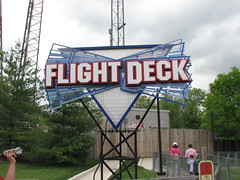
A): Why do they need to retain the old theme for the ride? What themeing did Top Gun really have to begin with that a simple paint scheme change couldn’t have transformed it into something new and unique? It’s a sparrow’s flight swooping through the backwoods, since when did the grey Naval themeing ever work to begin with? (Also the logos for the new names look like they’re bought in bulk)
B): Why would they want to retain the old theme for the ride? People overheard in the queues refer to the changeovers in park with the negative form of “it used to be Paramount” rather than a positive form of “it has a new identity”. There is no new identity to be found in the park, just an empty husk of the old one. 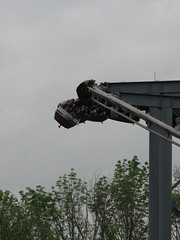
I’ll use those thoughts to transfer into my next couple reviews, starting with Top Gun… err, Flight Deck. This is probably one of the better suspended coasters devised. As I recall Canada’s Wonderland’s Vortex is the exact same layout but with shorter trains resulting in increased speed and swinging, but without quite as good, wooded terrain to work with, plus a very close fly-by of Son of Beast’s structure. The only grievance I have to levy against this ride is that it’s much too short. Like the mine rides, the original Arrow suspended coasters found a lot of their pleasures in having a lengthy, more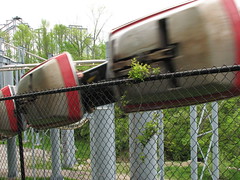 complex ride with multiple lifts, whereas Flight Deck, after the first drop and elevated sharp first turn, is just an overdrive of back-and-forth fast paced swinging until it ends some 45 seconds later. Big Bad Wolf is probably the ride that combined the best the fast-paced nature of Flight Deck or Vortex with the longer, more complex layering found on the earlier suspendeds. Of course there’s also Eagle Fortress in South Korea which appears to be operating complex ride with multiple lifts, whereas Flight Deck, after the first drop and elevated sharp first turn, is just an overdrive of back-and-forth fast paced swinging until it ends some 45 seconds later. Big Bad Wolf is probably the ride that combined the best the fast-paced nature of Flight Deck or Vortex with the longer, more complex layering found on the earlier suspendeds. Of course there’s also Eagle Fortress in South Korea which appears to be operating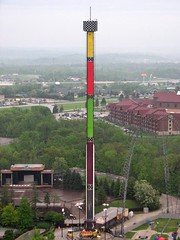 on an entirely different level altogether… on an entirely different level altogether…
Next up is Drop Zone: Stunt Tower… err, Drop Tower (okay, I’ll stop doing that now). The line for this one had been really short on my last visit here in 2007, and while there was maybe a cycle’s wait for it this time around it really wasn’t bad at all. At least it gave us a chance to enjoy the tremendous gust of wind that blows through the queue just after that giant ring lands back on the boarding pad. I’m never quite sure of how I feel about these drop rides (except for the S&S towers, which are always lame unless they’re at Indiana Beach). On the one hand, especially on Kings Island’s version which features the extreme height and rotating ascension, I still become nervous. On the other, for a ride that’s basically nothing but a long build-up to an exciting climax, getting off I always have the feeling that the proceedings are somewhat anti-climactic.
This now leaves one final ride to be reviewed in the area and it’s a big one:
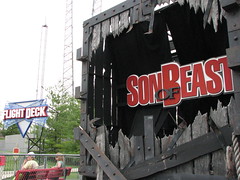 Son of Beast Son of Beast
The most egregious roller coaster dereliction since ever. What were the designers thinking… or smoking… or injecting into their arms… when they built this ride? This enormous heap of fail would make better use as recycled toilet paper to wipe my sorry behind with than anything even approaching a roller coaster.
Such are examples of comments amongst internet newsgroup members that reflect their personal feelings towards the Son of Beast. So hold on to your hats when you hear what I’m about to say… Son of Beast is nearly as good as Diamondback.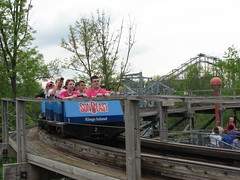
If you haven’t read my Diamondback analysis do so here as that may fit the above comment in better context. And I’ll admit, when I last experienced it before the accident and subsequent overhaul in 2004, it was bad. Really bad. The level of roughness was simply intolerable. This is one of those great ironies, since when the ride was first announced there was all this fuss over the trains Premier rides were designing for it, how they represented the most advanced, cutting edge design for wooden roller coaster trains, how they were by far the safest coaches ever designed for a woody and included features to ensure the best ride experience such as wheels that contained a layer of shock absorption. While a seemingly impressive technical background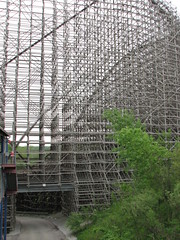 it proved very short-sighted in terms of safety, apparently occurring to no one that so much advanced design and technology would make the cars very heavy and inflexible, chewing up the soft wooden track and putting it in horrible maintenance condition, while the riders would receive every bump and jolt from said deteriorating track. it proved very short-sighted in terms of safety, apparently occurring to no one that so much advanced design and technology would make the cars very heavy and inflexible, chewing up the soft wooden track and putting it in horrible maintenance condition, while the riders would receive every bump and jolt from said deteriorating track.
But all that’s behind the ride now, unfortunately the signature vertical loop has been removed, but the ride has received a complete re-tracking and new lightweight trains, so of course it will continue to be bashed by the enthusiast community with extreme discrimination. Honestly, the ride’s no longer uncomfortable. I’m not sure why I’m still reading reviews that say it is, since on my three rides on the new Son of Beast (in 2007 and 2009, twice in the back and once in the front) all were totally tolerable. The biggest disappointment is that the new trains, while fine, are relocated from Myrtle Beach’s former Hurricane wooden coaster rather than purchased specifically for this ride. Two standard, six car trains on a coaster this scale? On the plus side stacking is rarely a problem, and thanks to the rides poor reputation lines weren’t out of control long, but still the wait seemed to be moving very slow. Apparently RCCA (the builders of the coaster itself) messed up the blocking configuration badly so the main brake run can only function as a single block instead of a double, thereby eliminating the feasibility of a three train operation. are relocated from Myrtle Beach’s former Hurricane wooden coaster rather than purchased specifically for this ride. Two standard, six car trains on a coaster this scale? On the plus side stacking is rarely a problem, and thanks to the rides poor reputation lines weren’t out of control long, but still the wait seemed to be moving very slow. Apparently RCCA (the builders of the coaster itself) messed up the blocking configuration badly so the main brake run can only function as a single block instead of a double, thereby eliminating the feasibility of a three train operation. 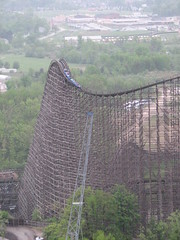 But still, this ride is calling for seven or eight car trains instead of a simple six. But still, this ride is calling for seven or eight car trains instead of a simple six.
The first part of the new coaster is quite amazing, starting with a short pre-lift section that drops a good 50 feet and lets you get a good look at the massive size of what’s to come as you slowly, inevitably make the rounds to that colossal lift, an intimidation factor that seems sadly missing from many other large-scale coasters including Diamondback. The lift is loud, dangerously so. Plug your ears on the way up because while it may not lead to any immediate lawsuits the way the track collapsing did in 2006, the overall long term damage done to people’s eardrums likely exceeds any damage done from that singular, attention grabbing incident. After the crest, instead of diving straight down, the coaster teases us once more with another amazing tension-building showoff. I must wonder who during the design process thought that it was an efficient use of resources to design it with such a wide turn right off the top of the lift when you’re having to support it 200 ft. in the air. But since they did, we at least now have one of the most impressive coaster structures to look at, and it’s a great build-up to that first drop as well.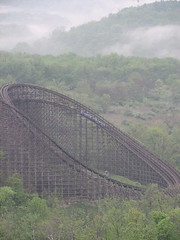 The drop and speeds feel incredibly amplified by the wooden nature of the ride, not at all rough on the pullout (in fact it probably equals the smoothness of many Gravity Group or Great Coasters projects), but the slight edge lent from the wooden track makes just the raw speed feel much more intense than anything else found this side of Top Thrill Dragster. The drop and speeds feel incredibly amplified by the wooden nature of the ride, not at all rough on the pullout (in fact it probably equals the smoothness of many Gravity Group or Great Coasters projects), but the slight edge lent from the wooden track makes just the raw speed feel much more intense than anything else found this side of Top Thrill Dragster.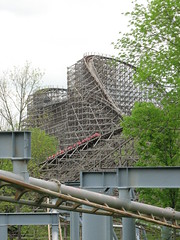
The next hill that leads into the gigantic double helix is still a show-stopper. This ride might not focus much on sharp dynamic contrasts and intense forces the way others would but frankly for this element it doesn’t need to. In the back especially there seems to be a sort of ‘hunting’ effect in the train as if it’s trying to come off the tracks. Again, never uncomfortable, but very unnerving and a real display of power this ride has. I love it.
Unfortunately after the helix is where the ride for the most part ends. There is then a very long (and useless) mid course block brake, before diving down towards where the loop used to be. There’s now a slight s-curve hill which is far too reserved to provide anything interesting.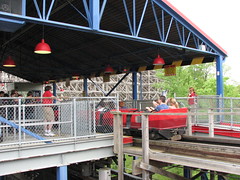 The second helix buried behind the lift structure pales compared to the first, and I would almost criticize it for being too smooth. Still, just being encased in the shadow of such a magnificent structure is interesting enough, and there’s some pretty good head choppers on the exit. The final hill, turn around and rise into the brakes are just worthless. Oversized, forceless and none of the signature speed and power found in the first part of the coaster. The second helix buried behind the lift structure pales compared to the first, and I would almost criticize it for being too smooth. Still, just being encased in the shadow of such a magnificent structure is interesting enough, and there’s some pretty good head choppers on the exit. The final hill, turn around and rise into the brakes are just worthless. Oversized, forceless and none of the signature speed and power found in the first part of the coaster.
Some have suggested that Intamin’s plug-and-play wood coaster design should be retrofitted to the ride to make it great. A good idea and an improvement to be sure, but I feel that would make the coaster just a lesser version of Diamondback, since very little air or other strong forces would be found along the course.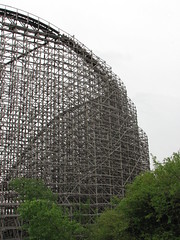 The ride isn’t just about 200 ft. tall drops and 78 mph speeds, it’s about 200 ft. tall drops and 78 mph speeds taken with raw, untamed wooden coaster technology. What I think would work well to make the ride the top-tener it potentially could be would be if Kings Island could hire the Gravity Group to do a second extensive re-working of the ride. I’m sure another surface retracking wouldn’t hurt especially with GG’s techniques. Mostly I would like to see the addition of some 14 or 16 bench Timberliner trains added to both increase capacity and improve the riding experience while still maintaining the wooden coaster edge. They could also hopefully re-build the main brake sequence so it could accommodate three trains. I’m also fairly certain that the Timberliners might feature secure enough restraints (haven’t seen a finished version of them yet) that maybe the loop could be restored? The second half of the ride just has so little going for it, and without the loop the coaster still feels a bit too close to Diamondback. More pie-in-the-sky hopes, but I’d like to see the track after the second helix completely razed and build from scratch a new finale featuring a much tighter, forceful Gravity Group design to finish off the ride. That’s pretty much all wistful thinking, probably I should be grateful if Kings Island The ride isn’t just about 200 ft. tall drops and 78 mph speeds, it’s about 200 ft. tall drops and 78 mph speeds taken with raw, untamed wooden coaster technology. What I think would work well to make the ride the top-tener it potentially could be would be if Kings Island could hire the Gravity Group to do a second extensive re-working of the ride. I’m sure another surface retracking wouldn’t hurt especially with GG’s techniques. Mostly I would like to see the addition of some 14 or 16 bench Timberliner trains added to both increase capacity and improve the riding experience while still maintaining the wooden coaster edge. They could also hopefully re-build the main brake sequence so it could accommodate three trains. I’m also fairly certain that the Timberliners might feature secure enough restraints (haven’t seen a finished version of them yet) that maybe the loop could be restored? The second half of the ride just has so little going for it, and without the loop the coaster still feels a bit too close to Diamondback. More pie-in-the-sky hopes, but I’d like to see the track after the second helix completely razed and build from scratch a new finale featuring a much tighter, forceful Gravity Group design to finish off the ride. That’s pretty much all wistful thinking, probably I should be grateful if Kings Island ever decides to swap out anti-roll backs on the lift for something quieter. If nothing else, Gravity Group could replace just a couple washers and the ride would automatically gain more sympathy from enthusiast communities. ever decides to swap out anti-roll backs on the lift for something quieter. If nothing else, Gravity Group could replace just a couple washers and the ride would automatically gain more sympathy from enthusiast communities.
One last major coaster I forgot to mention is Vortex. I was hoping to score several Vortex rides since every time I go to Kings Island, despite short lines and possibly being my second favorite ride in the park, I somehow manage to miss this one after getting only a ride or two in. This is my favorite of the large-scale Arrow multi-loopers. The Great American Scream Machine on paper would seem to be a better ride, but that one has a problem of seemingly running out of speed and height very rapidly, so that by the final corkscrews the ride feels no larger than a standard double corkscrew model. Vortex makes great use of moments that build in momentum, rather than lose it. First there’s the first drop, which rather than a twisting drop found on the other mega-loopers, Vortex features a tight, flat turn that whips into a straight, steep, kind of scary, ejector laden first drop if you’re in the back, which is where I’m almost always found. Instead of blasting through a first vertical loop in mere seconds, the ride takes it’s time with a large swooping curve, holding the inversions until later. Out of the turn is a long, descending straightaway that builds momentum and anticipation as it surges into the tight double loops. After the loops is another terrifying moment, the ultra-sharp turn of death that leads into the midcourse. How such a sharp turn is managed to be taken at such high speeds and not result in whiplash is beyond me, but I always have to think, “oh shit, not going to make it problem of seemingly running out of speed and height very rapidly, so that by the final corkscrews the ride feels no larger than a standard double corkscrew model. Vortex makes great use of moments that build in momentum, rather than lose it. First there’s the first drop, which rather than a twisting drop found on the other mega-loopers, Vortex features a tight, flat turn that whips into a straight, steep, kind of scary, ejector laden first drop if you’re in the back, which is where I’m almost always found. Instead of blasting through a first vertical loop in mere seconds, the ride takes it’s time with a large swooping curve, holding the inversions until later. Out of the turn is a long, descending straightaway that builds momentum and anticipation as it surges into the tight double loops. After the loops is another terrifying moment, the ultra-sharp turn of death that leads into the midcourse. How such a sharp turn is managed to be taken at such high speeds and not result in whiplash is beyond me, but I always have to think, “oh shit, not going to make it this time” right before we blow through this turn with ease. Going back to that motif of building momentum established with the first straightaway into the loops, this second half of the ride featuring four inversions is basically one continuous buildup until it’s over. First the corkscrews, not only do they dangle us high above the ground but they’re threaded improbably between the two loops. The train picks up speed quickly out of these and enters the signature batwing element, the most unique and intense singular element found on the ride, and partially buried in a trench for added effect. The only moment that does not serve the ride well is the final helix, but it’s not a problem since it doesn’t detract from other elements but simply acts as a bonus after the would-be finale of the batwing. this time” right before we blow through this turn with ease. Going back to that motif of building momentum established with the first straightaway into the loops, this second half of the ride featuring four inversions is basically one continuous buildup until it’s over. First the corkscrews, not only do they dangle us high above the ground but they’re threaded improbably between the two loops. The train picks up speed quickly out of these and enters the signature batwing element, the most unique and intense singular element found on the ride, and partially buried in a trench for added effect. The only moment that does not serve the ride well is the final helix, but it’s not a problem since it doesn’t detract from other elements but simply acts as a bonus after the would-be finale of the batwing.
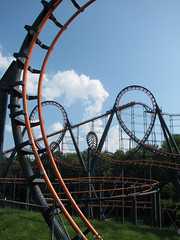 Unfortunately we found upon re-entering the park after the rain storm that for some inexplicable reason every coaster in the park was reduced to one-train operation, with the exception of Beast and Diamondback (and I think Backlot Stunt Coaster; never went on that one) which were down to two, although Diamondback was suffering from some mechanical problems before the storm which could have also been part of the cause. Vortex and Son of Beast definitely suffered the most for this; what was a queue that didn’t even leave the station ended up taking nearly 25 minutes to get through, so unfortunately it was only one ride on this visit as well. We wrapped up the night with two rides on Diamondback (could have managed more, but again, the reduced capacity really slowed things down; Unfortunately we found upon re-entering the park after the rain storm that for some inexplicable reason every coaster in the park was reduced to one-train operation, with the exception of Beast and Diamondback (and I think Backlot Stunt Coaster; never went on that one) which were down to two, although Diamondback was suffering from some mechanical problems before the storm which could have also been part of the cause. Vortex and Son of Beast definitely suffered the most for this; what was a queue that didn’t even leave the station ended up taking nearly 25 minutes to get through, so unfortunately it was only one ride on this visit as well. We wrapped up the night with two rides on Diamondback (could have managed more, but again, the reduced capacity really slowed things down;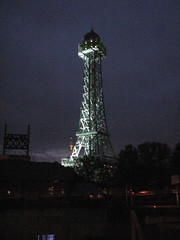 the train was being held on the main brake run instead of the one right behind the station as it normally is, so the time it took to get off the main run, make the turnaround and back into the station after the other train dispatched held things up a great deal) and then three on the Beast, which didn’t have much of any line, thankfully, although they did hold up the entire ride for a good twenty minutes when there were only two cycles left to load because they were launching the nightly fireworks from back near the ride area; apparently the fear is we’ll all catch on fire if they run it while the fireworks are going, and then they had to send maintenance around the ride just to make sure it hadn’t burned down. the train was being held on the main brake run instead of the one right behind the station as it normally is, so the time it took to get off the main run, make the turnaround and back into the station after the other train dispatched held things up a great deal) and then three on the Beast, which didn’t have much of any line, thankfully, although they did hold up the entire ride for a good twenty minutes when there were only two cycles left to load because they were launching the nightly fireworks from back near the ride area; apparently the fear is we’ll all catch on fire if they run it while the fireworks are going, and then they had to send maintenance around the ride just to make sure it hadn’t burned down.
After last rides we left to drive to our Louisville hotel that night for Six Flags Kentucky Kingdom the next day.
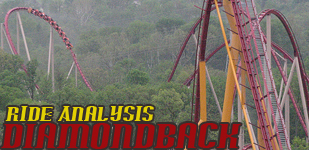 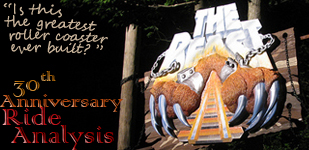
Charlotte, North Carolina – Sunday, May 25th, 2008
While the focal point of the trip, Hard Rock Park, ended up being a ghost town, pulling into Carowinds two days later revealed the complete opposite scenario, the parking lot bumper to bumper with cars trying to get in, and the front lot was quite full only ten minutes after opening so we made our way around to the 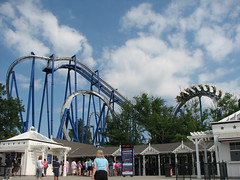 back entrance. It’s quite an impressive entryway for being a non-main entryway, Afterburn towering over head, the batwing maneuver soaring over and under the pathway, it made me quite anxious to get riding. We fit a quick ride on Afterburn’s front row with less than a ten minute wait, and then moved on to explore the rest of the park before it all became too busy (most of the crowds were still focused on rides near the front gate; I wouldn’t advise trying Vortex or Nighthawk as first rides of the day unless you’re right there when the main gates open). We actually made the Scooby-Doo Haunted Mansion our second ride in the park, since it didn’t look to have a long wait, although it ended up loading slow. The ride was very mediocre, my mom needed to ask me why that was necessary when we got off. back entrance. It’s quite an impressive entryway for being a non-main entryway, Afterburn towering over head, the batwing maneuver soaring over and under the pathway, it made me quite anxious to get riding. We fit a quick ride on Afterburn’s front row with less than a ten minute wait, and then moved on to explore the rest of the park before it all became too busy (most of the crowds were still focused on rides near the front gate; I wouldn’t advise trying Vortex or Nighthawk as first rides of the day unless you’re right there when the main gates open). We actually made the Scooby-Doo Haunted Mansion our second ride in the park, since it didn’t look to have a long wait, although it ended up loading slow. The ride was very mediocre, my mom needed to ask me why that was necessary when we got off.
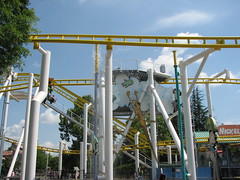 With Thunder Road down for the first part of its extensive 5-year maintenance plan, we ended up looking at the Flying Super Saturator for our next experience. I was keen to give this one a go-around because back when we visited the rumor mill was speculating that it was looking to be on the chopping block at the end of the year, although at the time we didn’t know what might replace it. That said, I had a lot of reservations about it as well because I am not one that enjoys getting soaked in street clothes, and I knew in advance that the entire queue took place underneath the attraction where there were plenty of opportunities to get doused against my own will. But the line was still non-existent at this hour of the day, and lo and behold… most of the water effects were turned off. The cars were still carrying their water-bomb loads meaning I had to be careful in the queue that some smartass above wouldn’t dump their load on us, With Thunder Road down for the first part of its extensive 5-year maintenance plan, we ended up looking at the Flying Super Saturator for our next experience. I was keen to give this one a go-around because back when we visited the rumor mill was speculating that it was looking to be on the chopping block at the end of the year, although at the time we didn’t know what might replace it. That said, I had a lot of reservations about it as well because I am not one that enjoys getting soaked in street clothes, and I knew in advance that the entire queue took place underneath the attraction where there were plenty of opportunities to get doused against my own will. But the line was still non-existent at this hour of the day, and lo and behold… most of the water effects were turned off. The cars were still carrying their water-bomb loads meaning I had to be careful in the queue that some smartass above wouldn’t dump their load on us,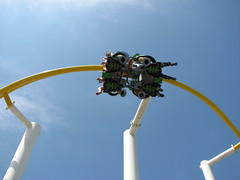 but we made it up to the station without a drop on us. Operations were quite slow, but with so few people waiting we made it to the platform in less than five minutes. And then, just as we were next in line, I heard a funny noise behind me. Turning around, I saw every water feature the ride had to offer had just been turned on. Uh-oh. Do I bail? The fact that I had already made it through the queue without getting wet and I knew this might be my only chance to ride were the only things that kept me waiting, and I figured a backward facing ride wouldn’t be so bad, so as soon as the gates opened I made a beeline to claim the back seat, leaving a father with his young daughter to have fun facing forward. “No hard feelings,” he told us. “I think she wants to get really wet”. but we made it up to the station without a drop on us. Operations were quite slow, but with so few people waiting we made it to the platform in less than five minutes. And then, just as we were next in line, I heard a funny noise behind me. Turning around, I saw every water feature the ride had to offer had just been turned on. Uh-oh. Do I bail? The fact that I had already made it through the queue without getting wet and I knew this might be my only chance to ride were the only things that kept me waiting, and I figured a backward facing ride wouldn’t be so bad, so as soon as the gates opened I made a beeline to claim the back seat, leaving a father with his young daughter to have fun facing forward. “No hard feelings,” he told us. “I think she wants to get really wet”.
It starts with an all-dry lift, and then teases us mercilessly with an s-curving drop that takes place over the main midway where there are also no water guns. This was one of the few coasters I’ve been on in recent memory in which I was unfamiliar with the layout before riding, so I had no idea when the waterworks were about to start. Suddenly, ba-boom! A huge water fountain launches liquid up the carriages underside, leaving our legs completely soaked. I’m quite positive the front row took the hardest hit. Most of the regular soakers were of little danger to us in the backwards position, but I also had no way to prepare for when the next canon would hit. A waterfall got my shoulders pretty good, but other than that the rest of the ride seemed to keep us fairly dry. Of course that wasn’t counting a second water cannon near the end of the ride that gave my shorts a good soaking. As we made the way around the final turn, relieved I wasn’t that much wetter than on a normal log flume, I remembered I had the opportunity to pull the lever that dispenses the water our vehicle was carrying, and pulled it in time to make a fellow just getting off the ride have to jump out of the way, which I took tremendous pleasure in watching. Getting off I saw the father and daughter in the front row were drenched to the bone. Most of the regular soakers were of little danger to us in the backwards position, but I also had no way to prepare for when the next canon would hit. A waterfall got my shoulders pretty good, but other than that the rest of the ride seemed to keep us fairly dry. Of course that wasn’t counting a second water cannon near the end of the ride that gave my shorts a good soaking. As we made the way around the final turn, relieved I wasn’t that much wetter than on a normal log flume, I remembered I had the opportunity to pull the lever that dispenses the water our vehicle was carrying, and pulled it in time to make a fellow just getting off the ride have to jump out of the way, which I took tremendous pleasure in watching. Getting off I saw the father and daughter in the front row were drenched to the bone.
Despite the fact that I always fear them, I somehow end up enjoying most water rides I go on. The amount of jitters I get over wondering if I’ll be soaked or spared always seems to be in disproportionate quantities to the actual level of wetness I get. The exceptions are on rides where you’re stuck in a slow-moving flume, watching Niagara Falls approach, and I can’t do anything but count down the seconds I have left until I’m to be held underwater for five seconds. That’s just cruel. Besides, I always dry off faster than I expect I will, provided I have some coasters line up to try next. Our next ride ended up being in the rear seat of the Carolina Goldrusher, a coaster I wouldn’t label an ideal wind-tunnel to dry off on.
 For a mine train it’s not bad, but come to think of it I’m normally a fan of most mine trains I go on (even silly ones like the Cedar Creek Mine Ride), while this one left me feeling rather ‘meh’. Mostly it’s just all too laid-back and slow, which isn’t always a problem in and of itself, but it also simply does not provide enough compared to some of the other endlessly meandering mine trains Arrow built. After the first lift the only thing that’s really of any note is a helix partially buried in a trench. This would work as a good build-up, but just as it seems to finally work up some speed we round a bend and are confronted with a second undersized lift. This one again starts with a slow straightaway off the top, getting halfway there with a helix before it quits, then a tunnel dive before it quits again. That’s actually not to diss on the Goldrusher too much, since like I said I’m always a fan of the classic Arrow mine trains and this one does have a couple of fun, unique bits in it, it just that Carolina Goldrusher was probably Arrow’s weakest effort during this time period. The fact that the seats were about six inches deep and there was nearly no legroom didn’t work to the coaster’s advantage either. For a mine train it’s not bad, but come to think of it I’m normally a fan of most mine trains I go on (even silly ones like the Cedar Creek Mine Ride), while this one left me feeling rather ‘meh’. Mostly it’s just all too laid-back and slow, which isn’t always a problem in and of itself, but it also simply does not provide enough compared to some of the other endlessly meandering mine trains Arrow built. After the first lift the only thing that’s really of any note is a helix partially buried in a trench. This would work as a good build-up, but just as it seems to finally work up some speed we round a bend and are confronted with a second undersized lift. This one again starts with a slow straightaway off the top, getting halfway there with a helix before it quits, then a tunnel dive before it quits again. That’s actually not to diss on the Goldrusher too much, since like I said I’m always a fan of the classic Arrow mine trains and this one does have a couple of fun, unique bits in it, it just that Carolina Goldrusher was probably Arrow’s weakest effort during this time period. The fact that the seats were about six inches deep and there was nearly no legroom didn’t work to the coaster’s advantage either.
From the Carolina Goldrusher to the Carolina Cyclone. Again, while I’m generally a fan of Arrow multiloopers, Carowind’s version seems to be on the low-end of the spectrum. However the Goldrusher at least manages to serve a specific demographic (and also has some unique layout-oriented bits) while the Cyclone simply feels outmoded inside a park featuring half a dozen other looping attractions that do everything the Cyclone does but better. Despite officially being a “custom looping coaster” according to the RCDb, the simple 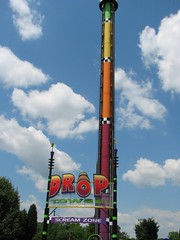 double loop/double corkscrew design really makes it feel like a slightly oversized production model design. This one also featured a decent amount of rattle while on board. It doesn’t bother me too much, but my mom is a bit more sensitive to that sort of thing and told me afterward how that one really wasn’t worth it. With the next coaster on our agenda appearing to be the nearby Hurler, I figured a quick amendment to the plans was necessary to space the two out, and we did Drop Tower instead. I really can’t comment much about the ride; it’s a basic drop tower (as the name implies) and a rather short one at that (at least for Intamin). The one notable thing about this tower was that, located far out of the way in a back corner of the park, there was absolutely no line for it, meaning if you’re a fan of towers you should get plenty of re-rides. It was also interesting because this was my first ever drop tower back when we were last here in early 1998 and this ride was the “big thing” at the park. Not only was the line multiple hours long then, but my memory recalls a tower several times taller and scarier than the one now standing before us; it’s interesting how these things seem to get smaller as we get older. double loop/double corkscrew design really makes it feel like a slightly oversized production model design. This one also featured a decent amount of rattle while on board. It doesn’t bother me too much, but my mom is a bit more sensitive to that sort of thing and told me afterward how that one really wasn’t worth it. With the next coaster on our agenda appearing to be the nearby Hurler, I figured a quick amendment to the plans was necessary to space the two out, and we did Drop Tower instead. I really can’t comment much about the ride; it’s a basic drop tower (as the name implies) and a rather short one at that (at least for Intamin). The one notable thing about this tower was that, located far out of the way in a back corner of the park, there was absolutely no line for it, meaning if you’re a fan of towers you should get plenty of re-rides. It was also interesting because this was my first ever drop tower back when we were last here in early 1998 and this ride was the “big thing” at the park. Not only was the line multiple hours long then, but my memory recalls a tower several times taller and scarier than the one now standing before us; it’s interesting how these things seem to get smaller as we get older.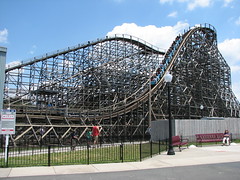
Next was the Hurler. I had been on Kings Dominion’s version the year before, and I recall stating that “not even the most experienced chemist could make me feel more neutral about this ride.” As wooden coasters, these rides just seem to be neither here nor there, forgotten rides stuck in a transitional era in wooden coaster history. Which is actually probably underselling them, since the fast ground-level turns stacked between a series of airtime hills do make for a rather decent riding experience, it’s just that they also tend to run rough (not to mention the hideous station and cracked concrete themeing around the entrance). Carowind’s version I’m happy to report seemed to be running a bit smoother and faster that day than Kings Dominions version, offering some nice lift off the air hills, and the only distracting shuffling was isolated to the turns, where it still wasn’t all-too bad. Even my mom commented that it was an okay ride, a sign that it was in fact smoother than would be expected. offering some nice lift off the air hills, and the only distracting shuffling was isolated to the turns, where it still wasn’t all-too bad. Even my mom commented that it was an okay ride, a sign that it was in fact smoother than would be expected.
I think by that time we were completely dried from the Super Saturator, and things were starting to heat up. The rapids or log flume seemed like a good idea to try next, and interesting all the rides we had done so far still had short lines despite what the parking lot suggested. However, after hiking over to the front entrance, we found that to not be the case. We stood in line for first the log flume for a minute before deciding it wasn’t worth it, and then the well-landscaped rapids ride they had. Ten minutes go by and we haven’t budged from our spots, so we ditch that one as well. Nighthawk still had nightmarishly long lines, and Vortex didn’t seem worth it yet either. I think we did the Carolina Skytower, 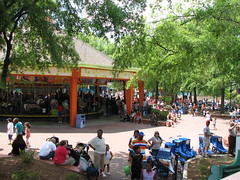 which had a short enough wait plus I could snap some pics, before finding a lunch. Why do I even bother getting lunches inside amusement parks any more, they are with few exceptions overpriced, foul-tasting and cold, with no nutritional value, and at over-crowded venues. Carowinds was not one of those exceptions (I think we ate at a place called Wings which was advertised as one of the better eating establishments in the park because it had air-conditioning; that was enough to sell us, apparently). We afterwards moved on to Afterburn again, and contemplating what else to do that we either hadn’t already done or knew had too long of a line, decided to explore the large Nickelodeon kid’s area that takes up most of the western (which is actually eastern) side of the park. which had a short enough wait plus I could snap some pics, before finding a lunch. Why do I even bother getting lunches inside amusement parks any more, they are with few exceptions overpriced, foul-tasting and cold, with no nutritional value, and at over-crowded venues. Carowinds was not one of those exceptions (I think we ate at a place called Wings which was advertised as one of the better eating establishments in the park because it had air-conditioning; that was enough to sell us, apparently). We afterwards moved on to Afterburn again, and contemplating what else to do that we either hadn’t already done or knew had too long of a line, decided to explore the large Nickelodeon kid’s area that takes up most of the western (which is actually eastern) side of the park.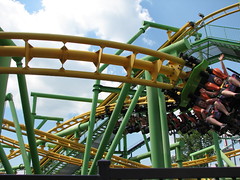
This is actually one of the more charming areas in the park, lots of colorful things to look at, plenty of tall, mature trees providing plenty of shade, multitudes of inviting rides where no single attraction dominates the area the way a major coaster is apt to do (we’ll see how much longer it stays like that). First we did the Rugrats Runaway Reptar, mostly because I’ve never 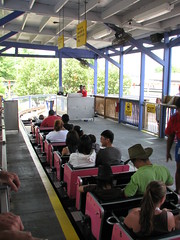 done a junior invert before and I was curious to see how they work. The answer: not well. Poor capacity led to an overly long wait, and then the actual ride ended up being rougher and more jarring than most full-sized SLCs I’ve been on. Thankfully the area’s other coaster, the classic junior woody re-themed to the Fairly Odd Coaster, ended up being a hidden gem. Okay, so it wasn’t anything too spectacular I would wait more than ten minutes for (which is about what the wait for this one was, thanks to two-train operation) but the mini-PTCs featuring minimal restraints are too-cute and great rolling stock for this ride, and being seating in the back row I was pleased to find a bit of whip over many of the hills. Smooth rolling, nestled in its own wooded grove away from the hustle and bustle of the park… I’d recommend this ride to the casual visitor over many of the larger and more disappointing coasters found inside Carowind’s gates. done a junior invert before and I was curious to see how they work. The answer: not well. Poor capacity led to an overly long wait, and then the actual ride ended up being rougher and more jarring than most full-sized SLCs I’ve been on. Thankfully the area’s other coaster, the classic junior woody re-themed to the Fairly Odd Coaster, ended up being a hidden gem. Okay, so it wasn’t anything too spectacular I would wait more than ten minutes for (which is about what the wait for this one was, thanks to two-train operation) but the mini-PTCs featuring minimal restraints are too-cute and great rolling stock for this ride, and being seating in the back row I was pleased to find a bit of whip over many of the hills. Smooth rolling, nestled in its own wooded grove away from the hustle and bustle of the park… I’d recommend this ride to the casual visitor over many of the larger and more disappointing coasters found inside Carowind’s gates.
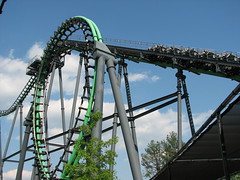 Speaking of disappointing rides, it was starting to get late into the afternoon and it seemed like it was time to bite the bullet and stick out the wait for Nighthawk. I’m not too sure what my personal feelings about the Vekoma Flying Dutchmen are. Sometimes I really like them, other times I really couldn’t care less for them, mostly it depends on how smooth they happen to be running (the ‘flying’ experience is all but lost otherwise), but even then I think my opinion of it might come down more to the mood I’m in that day. After waiting close to an hour in a completely exposed queue (my mom made a wise decision to watch me from the ground instead) I guess I wasn’t in a great mood, disembarking the coaster finding the only real redeeming quality of it was that I now had one more coaster I could check off my list, although banging my Speaking of disappointing rides, it was starting to get late into the afternoon and it seemed like it was time to bite the bullet and stick out the wait for Nighthawk. I’m not too sure what my personal feelings about the Vekoma Flying Dutchmen are. Sometimes I really like them, other times I really couldn’t care less for them, mostly it depends on how smooth they happen to be running (the ‘flying’ experience is all but lost otherwise), but even then I think my opinion of it might come down more to the mood I’m in that day. After waiting close to an hour in a completely exposed queue (my mom made a wise decision to watch me from the ground instead) I guess I wasn’t in a great mood, disembarking the coaster finding the only real redeeming quality of it was that I now had one more coaster I could check off my list, although banging my 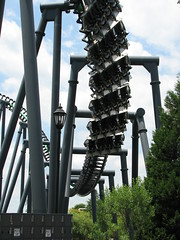 head hard against part of the fiberglass frame next to the headrest on the horseshoe maneuver didn’t help things either. head hard against part of the fiberglass frame next to the headrest on the horseshoe maneuver didn’t help things either.
My problem with these flying coasters (including most of B&M’s flying oeuvre) is that, ideally, a flying coaster shouldn’t take place on a square plot of flat land. Such a layout seems to deliberately undercut the purpose of a flying experience altogether, which ought take place through woods and over hillsides (SFMM’s Tatsu might be the only coaster that actually tries to do that, maybe Alton Tower’s Air as well). I suppose Nighthawk is probably the best of the Flying Dutchmen in that regard, since it at least takes place partly over a river, but it’s still not enough to make the concept work. Also, the flying sensation is hardly effective due to the awkward restraints that I spend most of the ride trying to figure out how it is that no one has ever fallen out. If I wanted to it would seem almost easy for my lower body to dangle out of the car since the only thing that’s keeping anything below my thigh in place are the loose, single-position ankle clamps I have to hook my feet on.
 Next I decide to try Vortex. This may or may not have been my first B&M experience back in 1998, I forget if I did Raptor and Mantis for the first time the summer of ‘97 or ‘98. I generally appreciate B&M’s stand-up designs since their layouts focus more on various twists and turns rather than just diving up and down a parade of individual elements. However, if efficient operations on the other coasters in the park were lacking in some regards, Vortex’s operations were nowhere in sight, perhaps they should check the lost and found… Next I decide to try Vortex. This may or may not have been my first B&M experience back in 1998, I forget if I did Raptor and Mantis for the first time the summer of ‘97 or ‘98. I generally appreciate B&M’s stand-up designs since their layouts focus more on various twists and turns rather than just diving up and down a parade of individual elements. However, if efficient operations on the other coasters in the park were lacking in some regards, Vortex’s operations were nowhere in sight, perhaps they should check the lost and found…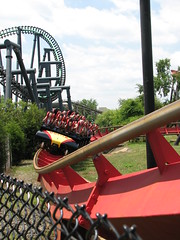 (shut up, I spent several minutes trying to make that pun work and wasn’t about to throw it away). Over an hour and a half in a line that would barely fill two full-sized switchbacks in one of Cedar Point’s queues, one train stacked on the brake run for up to three minutes waiting for the other to dispatch. The operators had no interest in running things at all. While the individuals working the ride were clearly to blame, I think this issue really comes down to negligence from the human resources department, since for the most part teens working at amusement parks are much the same in all parts of the country, and normally problems like this can be traced to a lack of institutions in place to motivate them. Dealing with the meticulous stand-up restraints doesn’t help, and I’m sure if the crew ever did at one point have any vim for their job they quickly became disillusioned after having to tell random jackasses for the thousandth time not to bend their legs when they’re locking the restraints. (shut up, I spent several minutes trying to make that pun work and wasn’t about to throw it away). Over an hour and a half in a line that would barely fill two full-sized switchbacks in one of Cedar Point’s queues, one train stacked on the brake run for up to three minutes waiting for the other to dispatch. The operators had no interest in running things at all. While the individuals working the ride were clearly to blame, I think this issue really comes down to negligence from the human resources department, since for the most part teens working at amusement parks are much the same in all parts of the country, and normally problems like this can be traced to a lack of institutions in place to motivate them. Dealing with the meticulous stand-up restraints doesn’t help, and I’m sure if the crew ever did at one point have any vim for their job they quickly became disillusioned after having to tell random jackasses for the thousandth time not to bend their legs when they’re locking the restraints.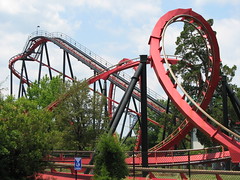
By lucky chance though being a single rider I was able to skip the last small stretch of queue to fill a front row spot (at least the person at the gate cared enough to be checking for single riders). The ride unfortunately was running somewhat rough on this occasion, and the layout isn’t particularly strong for a stand-up either, only offering a raised curve into an upward helix between the two inversions, and after the corkscrew the twisted finale peters out rather quickly. Most of the time spent on the ride was stacked on the brake run, so our train load was hardly enthusiastic when we got back to the station.
Alright, I guess that’s everything… oh wait, one more coaster I need to get; the Ricochet. I probably shouldn’t have, but there wasn’t much else in the park besides Afterburn I needed to re-ride, and sometimes these mouse rides turn out to be fun. My mother wisely decided to sit this one out as well, making three in a row. I don’t know how she has so much patience with me. The line for this one was also slow moving, not that these wild mice are designed for the crowds anyway. It has a nice entry façade to it that fits with the boardwalk theme in the area. Unfortunately this one proved to be a very trim brake heavy affair, only offering laterals on some of the upper switchbacks before the traditional coaster section on the lower levels ended up coming to a near-stop on each brake after every other drop. coaster I need to get; the Ricochet. I probably shouldn’t have, but there wasn’t much else in the park besides Afterburn I needed to re-ride, and sometimes these mouse rides turn out to be fun. My mother wisely decided to sit this one out as well, making three in a row. I don’t know how she has so much patience with me. The line for this one was also slow moving, not that these wild mice are designed for the crowds anyway. It has a nice entry façade to it that fits with the boardwalk theme in the area. Unfortunately this one proved to be a very trim brake heavy affair, only offering laterals on some of the upper switchbacks before the traditional coaster section on the lower levels ended up coming to a near-stop on each brake after every other drop.
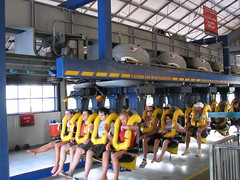 We got final rides on Afterburn before heading back out of the park for the evening. For some reason this coaster had the most consistently short lines throughout the day, and is probably the only coaster in Carowinds that I’d say makes the park worth it. A great setting for an inverted coaster, with plenty of trees and trenches to obscure the view, and with some very powerful and fast-paced elements. I’d describe the ride on a similar scale as Raptor, not that they’re really all that similar, but Afterburn’s extra height and speed probably equalizes Raptor’s extra length and ride time. The first drop is most excellent, diving partially downhill that helps amplify the speed a great deal, not that it needs much help since I think Afterburn might also be the fastest North American B&M invert this side of Alpengeist. The first loop is fantastic. Very narrow shaping allowing for not just a lot of height, but also a long vertical descent on the way down, and a fast rotational ‘flip’ over the very top. This is about as good as a standard clothoid loop can get. We then dive down a second ravine before speeding up into what appears to be another tall loop. We instead We got final rides on Afterburn before heading back out of the park for the evening. For some reason this coaster had the most consistently short lines throughout the day, and is probably the only coaster in Carowinds that I’d say makes the park worth it. A great setting for an inverted coaster, with plenty of trees and trenches to obscure the view, and with some very powerful and fast-paced elements. I’d describe the ride on a similar scale as Raptor, not that they’re really all that similar, but Afterburn’s extra height and speed probably equalizes Raptor’s extra length and ride time. The first drop is most excellent, diving partially downhill that helps amplify the speed a great deal, not that it needs much help since I think Afterburn might also be the fastest North American B&M invert this side of Alpengeist. The first loop is fantastic. Very narrow shaping allowing for not just a lot of height, but also a long vertical descent on the way down, and a fast rotational ‘flip’ over the very top. This is about as good as a standard clothoid loop can get. We then dive down a second ravine before speeding up into what appears to be another tall loop. We instead get an Immelmann, smartly replacing the forward flip over the top with one that sends us around our sides. The next maneuver, a zero-g roll, not only sustains the fast pace but is a natural evolution from the roll out of the Immelmann that immediately preceded it. Again, without losing a beat the way many B&M multiloopers are prone to do with oversize pull-outs, it’s another very fast roll up and over to the left, but this time we don’t follow through with the roll and instead dive straight down into a deep, mist-filled tunnel. I never realized until riding this just how rare authentic underground tunnels are on most B&M rides, and as a result this moment really stood out on Afterburn. Going five-for-five, the pace still hasn’t let up as it surges breathlessly into the second part of the batwing. get an Immelmann, smartly replacing the forward flip over the top with one that sends us around our sides. The next maneuver, a zero-g roll, not only sustains the fast pace but is a natural evolution from the roll out of the Immelmann that immediately preceded it. Again, without losing a beat the way many B&M multiloopers are prone to do with oversize pull-outs, it’s another very fast roll up and over to the left, but this time we don’t follow through with the roll and instead dive straight down into a deep, mist-filled tunnel. I never realized until riding this just how rare authentic underground tunnels are on most B&M rides, and as a result this moment really stood out on Afterburn. Going five-for-five, the pace still hasn’t let up as it surges breathlessly into the second part of the batwing.
 That first half of the ride probably ranks and one of B&M’s finest (and most underrated) efforts; not way out there creatively (besides the trenches/tunnels) but big, bold, frenetically paced, and overall just an amazing display of what their standard looping formula can do when they really try to make it something. The next moment, a large camelback hill over the station, is a bit of a pace-killer, not offering much for forces, and having to pull up high after the subterranean batwing, the loss of speed also becomes quite apparent here. All is not lost however, as this momentary let-up in speed only serves to throw us off-guard when the final inversion, a tight (tight) flatspin, throws us around our axis within a split second one last time. Like I said, however, compared to Raptor, Afterburn’s primary downfall is that it’s over just a bit too fast. The final 270 degree helix makes no real effort to do anything unpredictable, there more to get us lined back up with the brake run. Still, Afterburn was a very pleasant surprise, quite possibly my second-favorite B&M invert after Raptor (gotta love the intense helix finale on that one, still the only B&M invert I’ve been on that doesn’t end on a lame note) That first half of the ride probably ranks and one of B&M’s finest (and most underrated) efforts; not way out there creatively (besides the trenches/tunnels) but big, bold, frenetically paced, and overall just an amazing display of what their standard looping formula can do when they really try to make it something. The next moment, a large camelback hill over the station, is a bit of a pace-killer, not offering much for forces, and having to pull up high after the subterranean batwing, the loss of speed also becomes quite apparent here. All is not lost however, as this momentary let-up in speed only serves to throw us off-guard when the final inversion, a tight (tight) flatspin, throws us around our axis within a split second one last time. Like I said, however, compared to Raptor, Afterburn’s primary downfall is that it’s over just a bit too fast. The final 270 degree helix makes no real effort to do anything unpredictable, there more to get us lined back up with the brake run. Still, Afterburn was a very pleasant surprise, quite possibly my second-favorite B&M invert after Raptor (gotta love the intense helix finale on that one, still the only B&M invert I’ve been on that doesn’t end on a lame note)
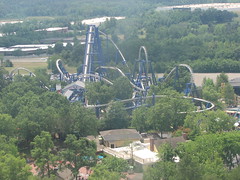 Overall Carowinds is a park that I think that I think could look like a decent place to visit on paper, but when we actually got there I found too many of the rides seemed like second-rate attractions. Actually, my second favorite ride experience of the day was probably the Flying Super Saturator, which I am sad to see is gone since it seemed like not only a great family ride but also a great hybrid water attraction to cool down on hot days. On the plus side, I will admit that the replacement of Geauga Lake’s boomerang in the Saturator’s old location was done as tastefully as I could expect from a relocation of a normally overused and frequently despised production model coaster. And with the Intimidator just announced, I do think I would definitely make a point to stop by again if I’m ever in the region. Overall Carowinds is a park that I think that I think could look like a decent place to visit on paper, but when we actually got there I found too many of the rides seemed like second-rate attractions. Actually, my second favorite ride experience of the day was probably the Flying Super Saturator, which I am sad to see is gone since it seemed like not only a great family ride but also a great hybrid water attraction to cool down on hot days. On the plus side, I will admit that the replacement of Geauga Lake’s boomerang in the Saturator’s old location was done as tastefully as I could expect from a relocation of a normally overused and frequently despised production model coaster. And with the Intimidator just announced, I do think I would definitely make a point to stop by again if I’m ever in the region.
|
|








Comments